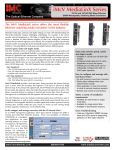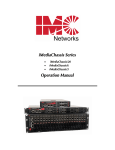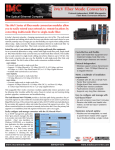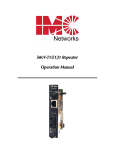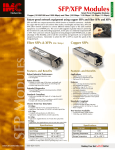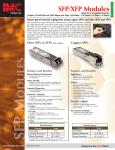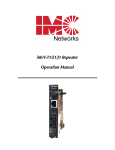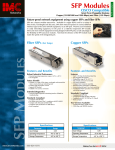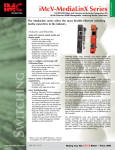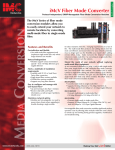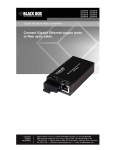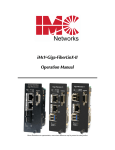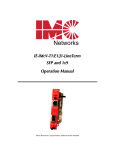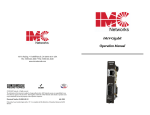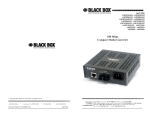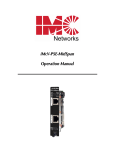Download IMC Networks iMcV-Giga-FiberLinX-II, TX/SFP (1x SFP/1250-ED Module)
Transcript
iMcV-Giga-FiberLinX-II SNMP-Manageable Optical Ethernet Demarcation Unit 10/100/1000 Mbps Ethernet An Optical Demarcation Unit Enabling Delivery of Transparent LAN Services while Providing Carrier-Grade Management and Line Provisioning Capabilities. Service providers who provide customers with Transparent LAN services must be able to remotely manage their customer premises equipment while keeping management and customer data traffic completely separated. Designed to meet the needs of service providers and administrators of enterprise campus networks, Giga-FiberLinX-II provisions point-to-point fiber optic connections and provides a unique management tool to monitor the entire link between two locations. Field-proven worldwide since 1999, the Giga-FiberLinX-II system is ideal for Optical Ethernet, FTTx and campus area network applications. The Giga-FiberLinX-II solution connects two remote networks over fiber optics and allows administrators to observe both the end-points, and the fiber link between them, as single management entities and not as separate elements. Host management traffic is not visible to the remote or customer network nor is access to the customer network required, guaranteeing end-to-end data integrity. Giga-FiberLinX-II allows for remote configuration and alerts administrators to any potential problems on the long-haul fiber run, provides vital information on link condition and reports data traffic statistics. In addition, it reduces the total cost of network equipment by functioning as a copper-to-fiber media converter, allowing deployment of lower cost copper switches at both ends of the fiber connection. Offering unparalleled flexibility, Giga-FiberLinX-II supports multiple fiber types including multi-mode and single-mode as well as single-strand fiber which can effectively double the capacity of installed fiber. The iMcV-Giga-FiberLinX-II features: • • • • One One One One 1000 Mbps fiber data port 10/100/1000 twisted pair data port additional 10/100/1000 twisted pair port (TX EXT) for management serial port with DB-9 connector Twisted pair ports auto-negotiate speed and duplex or can be set manually. Ports also feature Flow Control in FDX and Back Pressure Flow Control. Two models are also available with SFP ports, allowing users to easily accommodate changing fiber requirements; simply install a new SFP module rather than replacing an entire Giga-FiberLinX-II unit. www.imcnetworks.com 800-624-1070 Secure and flexible solution • Preserves complete end-to-end fiber connection and data integrity via SNMP • All management traffic remains isolated from the remote LAN • IEEE 802.1Q VLAN and 802.1p compliant • VLAN-tagging and Q-in-Q (double-tagging) segregates customer traffic Features and functionality • Transparency feature allows VLAN/nonVLAN traffic on same port • Provides differential priority • Remotely configure settings • LinkLoss and FiberAlert and loopback functionality for troubleshooting Minimizes networking costs • Avoid unnecessary service calls • When using Giga-FiberLinX-II in pairs, deploy less expensive copper switches at both ends End-to-End Solution • Giga-FiberLinX-II (as Host) for Central Office applications and Giga-FiberLinX-II (as Remote or Standalone) for Customer Premises Easy to configure and manage with GUIbased iView² • • • • Manage/monitor fiber traffic Includes RMON statistics SNMP V1 and V2c compatible Supports the Unified Management Agent (UMA) • Receive vital health information www.mediaconverter.com Full-Featured Giga-FiberLinX-II From a central location, network operators are able to receive real-time device and traffic statistics on the remote CPE, allocate bandwidth, turn services on or off, initiate loopback testing, change customer VLAN settings and adjust QoS policies assigned to different traffic types. • Management Port and VLAN Functionality — Having a separate management port as well as VLAN compliance keeps customer data and SNMP traffic separated. • Loopback Testing functionality loops back all frames arriving on the fiber port (except for the device’s management traffic). When in Loopback mode, the Giga-FiberLinX-II drops the link on the twisted pair port. • Troubleshooting Features — FiberAlert and LinkLoss along with LEDs assist in diagnosing potential problems on fiber optic networks. • Supports the Unified Management Agent (UMA) — Giga-FiberLinX-II has always supported Host/Remote environments, i.e. managing the Remote from the Host location. With UMA, the central location can manage all devices installed in an iMediaChassis with the single IP address of the chassis. Using the VLAN Functionality on Giga-FiberLinX-II Service providers routinely use IEEE 802.1Q Virtual Local Area Network (VLAN) tagging to secure, separate and differentiate customer traffic. The Giga-FiberLinX-II enables service providers to support multiple VLAN-based applications. • • • • IEEE 802.1Q VLAN compatible. Valid VLAN IDs are 1 to 4,094. Port-based VLAN tagging. Transparency Mode passes all data and respects the VLAN tag or lack thereof, i.e. allows a mixture of VLAN Tagged and Untagged traffic. • Configure to support VLAN trunking; the Giga-FiberLinX-II Application Examples Typical Application— Dual Giga-FiberLinX-II When used in pairs, a Giga-FiberLinX-II configured as a Host resides at the head-end while another Giga-FiberLinX-II, configured as a Remote, installs at the remote customer location, typically on the network edge where the customer network meets the service provider infrastructure. Via SNMP, the Giga-FiberLinX-II solution monitors the entire link and ensures data integrity while remaining isolated and completely transparent to the customer LAN. Typical Application— Single Giga-FiberLinX-II A single Giga-FiberLinX-II can be used as a singlesolution (CPE) application. Install a Giga-FiberLinX-II at the customer’s network edge and configure the device as a standalone. Connect the Giga-FiberLinX-II to a media converter at the central office or directly to a fiber switch. Manage the Giga-FiberLinX-II from the central office. can trunk up to 32 VLAN IDs for data, plus an additional for SNMP (Transparency Mode disabled). • IEEE 802.1p provides a 2-tier queue for differential prioritization of inbound and outbound traffic especially beneficial for traffic requiring high priority (e.g. VoIP; this traffic is serviced first). SNMP Management Made Easy FiberLinX modules features an SNMP management agent for monitoring the status and activity on copper and fiber ports at the remote end. Perform initial setup of the unit and modifications in the field via: iView² SNMP application, Telnet/TFTP, or local serial connection. • • • • • Enable features and change configuration settings from central office. Remote upgrades via Telnet/TFTP, serial port or mgt. software. Monitor both units and the fiber in between. Receive real-time monitoring and statistics. Create a secure management domain to isolate management domain broadcasts from TX Data ports on both units. • User-definable unit/port descriptions and information. GUI-Interface of iView² for iMcV-Giga-FiberLinX-II Physical Specifications Technical Specifications • Preserves complete end-to-end fiber connection integrity • Monitors far-end (remote) status without a physical presence or separate connection • Maintains security; all management traffic remains isolated from the remote network • Includes GUI-based iView² software • SNMP V1 and V2c compatible • Read/write IEEE 802.1Q VLAN-tags • Remote management and upgrades • QoS– IEEE 802.1p-based packet prioritization (2 queues [high/low] with 8 levels of priority) • Layer 2 packet switching, store and forward operation • Q-in-Q (extra-tagging) • IEEE 802.3x Flow Control • Includes DHCP and TFTP clients • Supports Telnet • Includes loopback test modes • AutoCross for MDI-II/MDI-X • Includes LinkLoss and FiberAlert • Features Auto-Negotiation and Selective Advertising • Installs in iMediaChassis, iMediaCenter chassis or MediaChassis (Requires two slots) • Supports the Unified Management Agent (UMA) • 50/125µm or 62.5/125µm multi-mode fiber • • • • • • • • • • • 9/125µm single-mode fiber Available for single-strand fiber Serial Port for management Supports Full-Duplex operation Includes diagnostic LEDs Hot-swappable architecture IEEE 802.3 10Base-T twisted pair IEEE 802.3u 100Base-TX twisted pair IEEE 802.3ab 1000Base-T twisted pair IEEE 802.3z 100Base-LX or SX fiber Includes DB-9 connector and cable for serial configuration Shipping Weight: .8 lbs (.36 kg) Regulatory Approvals: FCC Class B UL/cUL, CSA, CE Operating Temperature: 32° to 122°F (0° to +50°C); 5% to 90% (non-condensing), 0 – 10,000 ft. altitude Storage Temperature: -13° to +158°F (-25° to +70°C); 5 to 90% (non-condensing) • Forwarding rate: 14,880pps for 10 Mbps; 148,800pps for 100 Mbps; 1,488,000pps for 1000 Mbps • MTU: Supports over-sized packets up to 9,600 bytes • Connectors: RJ-45, and ST or SC Please refer to the SFP Module datasheet for technical specifications if using Giga-FiberLinX-II units with SFP ports. Technical Specifications (con’t.) IMC MIB: ·Traps (Cold Start, Warm Start, Authentication Failure, Link Up, Link Down, Remote Unit Lost, Remote Unit Back Online, Far End TX Link On and Far End TX Link Off)* · · · · · Link Status of Ports Port Type Fiber Type SNMP Port (Host/Remote) SNMP Agent IP Address (Host/Remote/Single) · Link Partner · · · · · · User-Definable Name of Product User-Definable ID/Name of Ports Enable/Disable Ports Enable/Disable FiberAlert Enable/Disable loopback modes Set Duplex Mode for Twisted Pair Ports · Set Auto-Negotiation/Speed for Twisted Pair Ports MIB-II (RFC 1213): · Packets Transmitted · Packets Received · Octets (bytes) Transmitted · Octets (bytes) Received · Plus All Standard MIB II Objects RMON Statistics: · Total Bytes · Total Packets · · · · · · · · · Broadcast Packets Multicast Packets CRC Align Errors Undersize Packets Oversize Packets Fragments Jabbers Collisions Distribution of Frame Size *Send traps to a virtually unlimited number of trap-host server destinations. Ordering Information iMcV-Giga-FiberLinX-II — SFP 56-14760 56-14761 iMcV-Giga-FiberLinX-II, TX/SFP (requires one SFP/1250-ED Module) iMcV-Giga-FiberLinX-II, SFP/SFP (requires two SFP/1250-ED Modules) iMcV-Giga-FiberLinX-II — Gigabit Ethernet 56-14869 56-14870 56-14871 56-14872 iMcV-Giga-FiberLinX-II, TX/SX-MM850-SC [300 m - 7.5 dB] iMcV-Giga-FiberLinX-II, TX/LX-SM1310-SC [10 km - 12 dB] iMcV-Giga-FiberLinX-II, TX/LX-SM1310/PLUS-SC [40 km - 23 dB] iMcV-Giga-FiberLinX-II, TX/LX-SM1550/LONG-SC [70 km 23 dB] Single-Strand Fiber* 56-14873 56-14874 56-14875 56-14876 56-14877 56-14878 56-14879 56-14880 iMcV-Giga-FiberLinX-II, TX/SSLX-SM1310-SC (1310xmt/1550rcv) [10 km - 9 dB] iMcV-Giga-FiberLinX-II, TX/SSLX-SM1550-SC (1550xmt/1310rcv) [10 km - 9 dB] iMcV-Giga-FiberLinX-II, TX/SSLX-SM1310/PLUS-SC (1310xmt/1550rcv) [40 km - 18 dB] iMcV-Giga-FiberLinX-II, TX/SSLX-SM1550/PLUS-SC (1550xmt/1310rcv) [40 km - 18 dB] iMcV-Giga-FiberLinX-II, TX/SSLX-SM1490/LONG-SC (1490xmt/1550rcv) [60 km - 20 dB] iMcV-Giga-FiberLinX-II, TX/SSLX-SM1550/LONG-SC (1550xmt/1490rcv) [60 km - 20 dB] iMcV-Giga-FiberLinX-II, TX/SSLX-SM1490/XLONG-SC (1490xmt/1550rcv) [80 km - 24 dB] iMcV-Giga-FiberLinX-II, TX/SSLX-SM1550/XLONG-SC (1550xmt/1490rcv) [80 km - 24 dB] CWDM Fiber 56-14858 56-14859 56-14860 56-14861 56-14862 56-14863 56-14864 56-14865 56-14866 56-14867 iMcV-Giga-FiberLinX-II, TX/CWDM-SM1430-SC iMcV-Giga-FiberLinX-II, TX/CWDM-SM1450-SC iMcV-Giga-FiberLinX-II, TX/CWDM-SM1470-SC iMcV-Giga-FiberLinX-II, TX/CWDM-SM1490-SC iMcV-Giga-FiberLinX-II, TX/CWDM-SM1510-SC iMcV-Giga-FiberLinX-II, TX/CWDM-SM1530-SC iMcV-Giga-FiberLinX-II, TX/CWDM-SM1550-SC iMcV-Giga-FiberLinX-II, TX/CWDM-SM1570-SC iMcV-Giga-FiberLinX-II, TX/CWDM-SM1590-SC iMcV-Giga-FiberLinX-II, TX/CWDM-SM1610-SC [80 [80 [80 [80 [80 [80 [80 [80 [80 [80 km km km km km km km km km km - 24 24 24 24 24 24 24 24 24 24 dB] dB] dB] dB] dB] dB] dB] dB] dB] dB] NOTE: iMcV-Giga-FiberLinX-II modules are double-wide and require two slots in a chassis. *These products have single-strand fiber technology. Deploy in pairs, or connect to another compatible IMC Networks single-strand fiber product. Go to www.imcnetworks/products/SSFX.cfm for more info. When ordering the RoHS version of a product, add an “8” to the front of the standard part number, eg. 56-10730 becomes 856-10730. Call for RoHS product availability. Related Products — iMcV Series Modules The iMcV Series includes 10 Mbps (iMcV-PIM), 100 Mbps (iMcV-LIM), autosensing 10/100 Mbps (iMcV-LIM 10/100), 155 Mbps ATM (iMcV-ATM) and Gigabit Ethernet (iMcV-Gigabit) copper-to-fiber media conversion modules as well as 10/100 and 10/100/1000 switching media converters (MediaLinX series). T1/E1/ J1 media converters (iMcV-T1/E1/J1), DS3/E3 media converters (iMcV-DS3/E3) and VDSL to Ethernet media converters (iMcV-VDSL-LANextender) are also available. In addition, IMC Networks has the most extensive line of protocol-independent (iMcV-S2MMs, iMcV-S2SMs and iMcV-M2MMs) fiber mode conversion modules. The iMcV series also includes: iMcV-FiberLinX, iMcV-WDM and iMcV-FiberWay modules. Single-strand fiber versions are available for many media converters. For more information on the various products in the iMcV Series, please refer to the IMC Networks Web site at: http://www.imcnetworks.com/Products/ProdDir.cfm IMC Networks IMC Networks IMC Networks IMC Networks Headquarters 19772 Pauling Foothill Ranch, CA 92610 TEL: 949-465-3000 FAX: 949-465-3020 [email protected] www.imcnetworks.com Europe Herseltsesteenweg 268 B-3200 Aarschot Belgium TEL: +32-16-550880 FAX: +32-16-550888 [email protected] Eastern US/Latin America 18840 US Hwy. 19 North Suite 400 Clearwater, FL 33764 TEL: 727-524-8152/524-8071 (Latin) FAX: 727-524-8432 [email protected] Fiber Consulting Services For information call: TEL: 949-465-3000 1-800-624-1070 (US/CAN) +32-16-550880 (Europe) [email protected] Copyright © 2006 IMC Networks. All rights reserved. The information in this document is subject to change without notice. IMC Networks assumes no responsibility for any errors that may appear in this document. Specific product names may be trademarks or registered trademarks and are the property of their respective companies. Document #56-90869 November 2006




